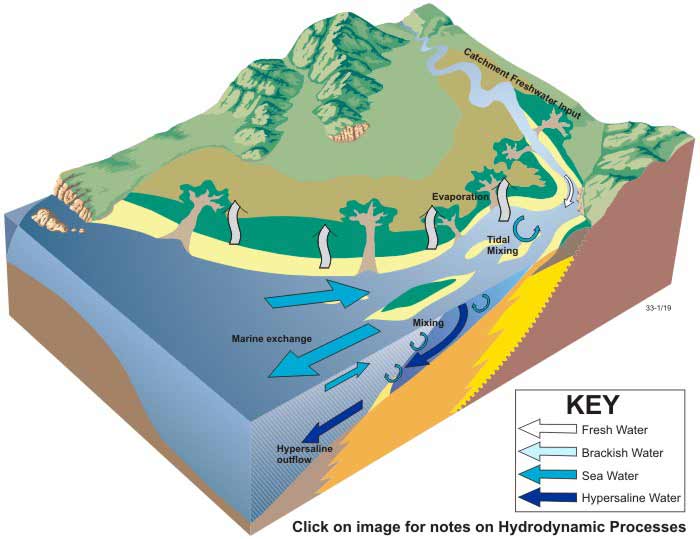
Negative hydrology processes in tide-dominated estuaries
1. Catchment freshwater input
Freshwater enters from the catchment. Although the volume of freshwater input varies regionally and temporally (depending on local catchment and climatic conditions), it is typically relatively low in negative estuaries.
2. Freshwater volume
Except during extreme events, the volume of freshwater entering the estuary is typically too low to cause significant stratification (Nunes et al., 1986). High tidal ranges may tend to accelerate mixing of any freshwater inputs, and marine water.
3. Salinity
High rates of evaporation cause increases in salinity within the estuary. The resulting high-density hypersaline water sinks beneath the buoyant marine water which penetrates through the estuary mouth, and flows out of the estuarine entrance into the coastal ocean through a process known as reverse stratification (Lennon et al., 1987). A large degree of mixing occurs between the two layers (de Silva Samarasinghe et al., 1987a). Circulation processes are complicated by the massive area of intricate dendritic drainage system (Wolanski et al., 1992).
4. Water exchange
Exchange of sea water and estuarine water occurs through the wide entrance of the estuary. Flood and ebb tides may follow different routes into and out of the estuary, and the tidal prism tends to be large. In negative estuaries, the net inflow of marine water exceeds the outflow of catchment-derived (fresh) water. In such cases, the hypersaline water is usually exported to the ocean (Wolanski, 1986a).
5. Saltflat environments
Saltflat environments are inundated rarely (e.g. 3-4 days per month), resulting in hypersaline groundwaters and often a saline crust on the surface (Ridd et al., 1997).
6. Evaporation
Evaporation is the dominant process in negative tide-dominated estuaries due to arid climatic conditions, and the extensive area of shallow intertidal environments. Aridity and the degree of evaporation may vary seasonally; however by definition evaporation in ‘negative’ estuaries is much larger than freshwater input (Heggie et al., 1999). Consequently, negative estuaries tend to have longer residence times than positive estuaries (Smith et al., 1989).


